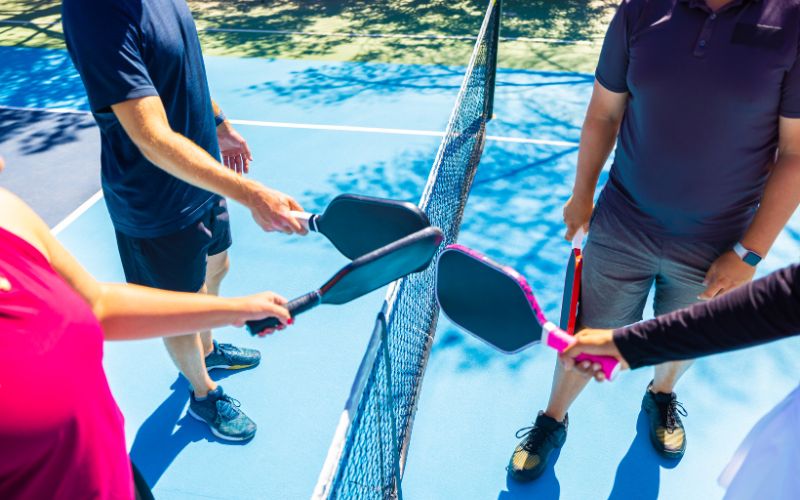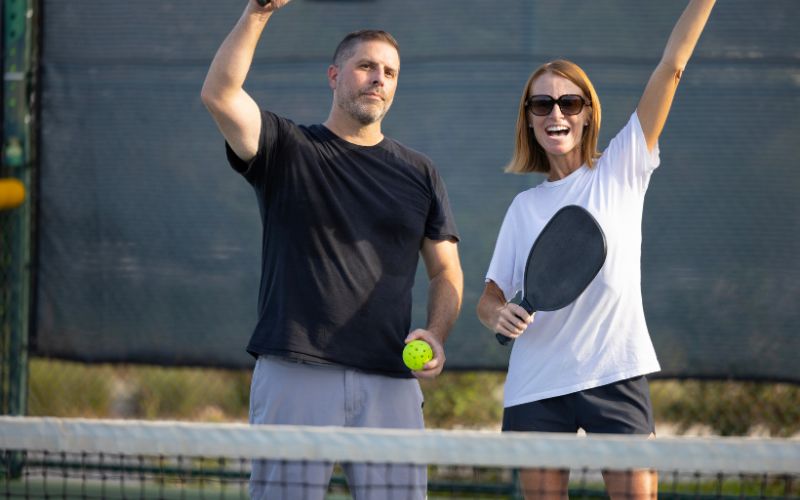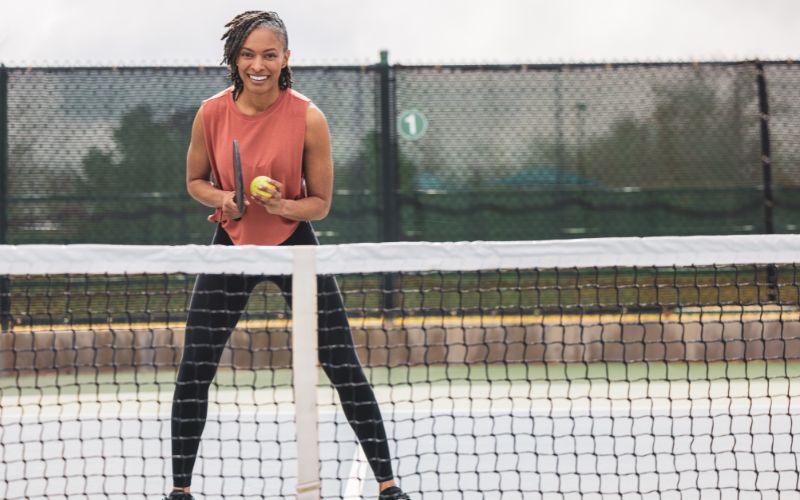Welcome to the exhilarating world of pickleball, where skill, finesse, and strategy converge in the pursuit of victory. In this guide, we delve into the artistry of ‘Pickleball Stroke: Mastering the 10 Essential Strokes.’ From the graceful finesse of dinks to the commanding force of groundstrokes, each stroke embodies the essence of this dynamic sport.
Join us on a journey to unlock the secrets behind these pivotal techniques, empowering players to elevate their game and conquer the court. Discover the strategies, nuances, and sheer power behind these ten essential pickleball strokes, designed to propel your mastery and enjoyment of this thrilling sport to new heights.
Understanding Basic Pickleball Strokes
1. Groundstroke
Description: A groundstroke refers to a shot played after the ball bounces on your side of the court. This stroke is usually performed from the back of the court and is crucial for maintaining control and setting up plays during rallies.
Technique:
- Forehand Groundstroke: For a forehand groundstroke, position yourself sideways to the net, take the paddle back, and swing forward as the ball approaches, aiming for a solid and controlled return.
- Backhand Groundstroke: Similar to the forehand, for a backhand groundstroke, position yourself sideways and execute a controlled swing with your backhand.
Purpose: Groundstrokes allow players to maintain consistency, control, and depth in rallies. They set up opportunities for more offensive shots while keeping the ball in play.
2. Volley
Description: A volley in pickleball involves hitting the ball before it bounces on your side of the court. It’s typically executed closer to the net and requires quick reflexes and hand-eye coordination.
Technique:
- Forehand Volley: Keep your paddle ready at the net, and as the ball approaches, make a controlled and concise forward stroke to volley it back.
- Backhand Volley: Similar to the forehand, maintain a ready position and execute a controlled backhand stroke for a backhand volley.
Purpose: Volleys are important for maintaining control near the net, allowing players to take advantage of opportunities and put pressure on opponents. They’re often used to end points quickly or set up winning shots.
3. Dink
Description: A dink is a soft, controlled shot hit just over the net with minimal force, aiming to arc the ball downward into the opponent’s non-volley zone. It’s usually executed with finesse and touch.
Technique:
- Forehand Dink: Keep your paddle face open and use a gentle stroke to softly guide the ball over the net.
- Backhand Dink: Similar to the forehand, execute a controlled and gentle backhand stroke to perform a backhand dink.
Purpose: Dinking is essential for strategy and control in pickleball. It’s used to create opportunities by forcing opponents closer to the net and setting up shots for more offensive plays. Dinks are particularly effective in neutralizing opponents and gaining control of the net.
Pickleball Basic Shots
1. The Serve
Description: The serve initiates every pickleball point. It involves hitting the ball diagonally over the net into the opponent’s service court. Players aim for consistency, placement, and sometimes adding spin to make it harder to return.
Purpose: A well-executed serve sets the tone for the point, allowing players to control the rally’s pace from the very beginning.
2. The Lob
Description: A lob is a high, arcing shot that sends the ball high into the air, typically over an opponent who is positioned closer to the net. Lobs are used strategically to reset the point, change the rhythm, or create opportunities for offensive plays.
Purpose: Lobs force opponents to move backward, disrupting their position near the net and potentially setting up a chance for an attacking shot.
3. Cross-Court Dink
Description: The cross-court dink is a controlled shot that travels diagonally over the net, aimed at the opponent’s non-volley zone. It requires touch and finesse to place the ball precisely while keeping it low and within the opponent’s reach.
Purpose: Cross-court dinks are deceptive shots used to create angles, move opponents, and open up opportunities for more aggressive plays.
4. The Drive
Description: The drive is a powerful shot hit with speed and often less arc, aimed at putting pressure on opponents by forcing them to react quickly. It’s executed closer to the net and requires good timing and technique.
Purpose: Drives are offensive shots designed to penetrate the opponent’s defense, aiming to overwhelm them with pace and placement.
5. Block Shot
Description: A block shot typically involves redirecting the opponent’s shot with minimal backswing, typically used when under pressure near the net. It requires quick reflexes and a compact stroke to return the ball.
Purpose: Blocking shots allows players to counter fast-paced attacks and regain control during intense exchanges at the net.
6. Deep Return Serve
Description: A deep return serve involves hitting the opponent’s serve deep into their court, aimed at pushing them back and limiting their opportunities for an aggressive response. It requires precision and control.
Purpose: A deep return serve puts pressure on the server, forcing them to hit a more challenging subsequent shot.
7. Backhand Punch
Description: A backhand punch is a swift and forceful shot executed on the backhand side, usually hit with minimal backswing and using a punching motion. It’s utilized to counter faster-paced shots or surprise opponents.
Purpose: The backhand punch can catch opponents off guard, allowing players to change the pace of the rally or seize control of the point.
8. Overhead Smash
Description: The overhead smash is a powerful shot executed by striking the ball forcefully overhead, aiming to hit it downwards with significant force. It’s usually utilized when presented with a high ball near the net.
Purpose: The overhead smash is an offensive weapon, often ending points by overwhelming opponents with speed and placement.
9. Third Shot Drops
Description: A third shot drop is a soft , controlled shot played as the third shot in a rally, intending to softly place the ball into the non-volley zone on the opponent’s side. It requires finesse and touch.
Purpose: The third shot drop aims to regain control of the net and initiate play while preventing opponents from launching aggressive attacks.
10. The Dink Fake
Description: The dink fake involves making a motion as if to hit a soft shot dink shot but instead executing a different shot, often with more power or a different angle. It’s used to deceive opponents and create openings.
Purpose: The dink fake disrupts opponents’ expectations, causing hesitation and potentially creating opportunities for winners or strategic plays.
11. Backspin Return Serve
Description: The backspin return serve involves applying backspin to the return shot, causing the ball to slow down and bounce differently. It’s used to neutralize the opponent’s serve by altering the ball’s trajectory.
Purpose: By using backspin, players can make the return serve more challenging to handle, disrupting opponents’ rhythm and potentially causing errors.
12. Around-the-Post Shot
Description: An around-the-post shot is a shot played by hitting the ball around the net post (outside the court boundaries). It’s an advanced hard shot used to surprise opponents by smashing the ball in an unconventional angle.
Purpose: The around-the-post shot is a flashy and unexpected shot that can catch opponents off guard, earning points through its unexpected trajectory.
13. Backhand Spin Dink
Description: The backhand spin dink is a dink shot executed with spin using the backhand side. It involves placing spin on the ball, making it curve or bounce unpredictably, often making it challenging for opponents to handle.
Purpose: The backhand spin dink combines finesse and spin to create an unpredictable shot, causing difficulty for opponents to anticipate and respond effectively.
Mastering these basic shots in pickleball equips players with a diverse arsenal to control rallies, deceive opponents, and capitalize on strategic opportunities during gameplay.
In the thrilling world of pickleball, mastering the ten essential strokes is the gateway to unlocking the finesse and dynamism that define this captivating sport. From the commanding force of groundstrokes to the strategic precision of dink shots, each stroke encapsulates the multifaceted nature of pickleball.
These fundamental techniques form the bedrock of a player’s arsenal, offering a spectrum of strategies to dominate the court. Whether it’s the graceful execution of a lob shot, the deceptive prowess of a dink fake, or the sheer power behind a third shot drives, each stroke presents a unique opportunity to outmaneuver opponents and control the tempo of the game.
The importance of these shots cannot be overstated. Groundstrokes maintain control and consistency, while volleys enable players to seize opportunities near the net. Dinks strategically lure opponents and set the stage for offensive maneuvers, while serves and lob shots disrupt rhythms and force adversaries to adapt.
Additionally, the subtleties of the third shot drop, backhand punch, and around-the-post shot reveal the depth of expertise required to master this sport. These shots not only showcase skill but also reflect the creativity and innovation players bring to the court.
In the realm of pickleball, such a fun shot not only elevates one’s game but amplifies the sheer enjoyment of the sport. It’s a fusion of skill and strategy, where each cool little shot and lob shot isn’t just a stroke but a canvas for players to craft their victories.
As players delve into the artistry behind these essential strokes, they embark on a journey of continuous improvement, refining techniques, and adapting strategies. Ultimately, it’s the amalgamation of these strokes—each serve that shoots straight, every dink that lands delicately—that defines a player’s mastery and paves the way for triumph on the pickleball court.






